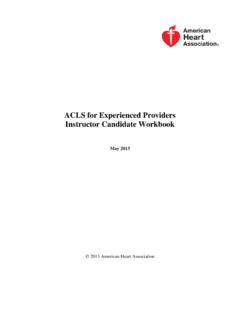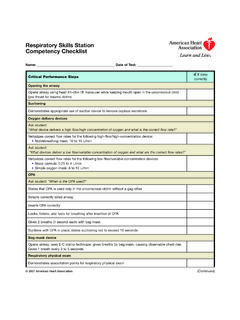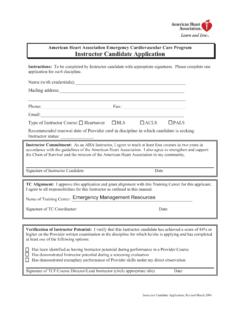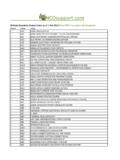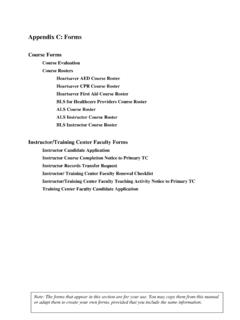Transcription of Advanced Cardiovascular Life Support Instructor Course ...
1 Advanced Cardiovascular life Support Instructor Course Faculty Guide May 2013 2013 american Heart association 2 ACLS Faculty Guide Contents Introduction .. 3 Background .. 4 The Early Days .. 5 AHA Mission .. 6 AHA Global Mission .. 6 Emergency Cardiovascular Care Mission .. 6 The Science Process and Why Materials Change Every 5 Years .. 7 Turning Science Into Training .. 8 Making an Impact .. 9 The Instructor -AHA Partnership .. 10 How the ACLS Instructor Course Works .. 10 Step 1: Prepare .. 11 Prepare Yourself .. 11 Find or List a 12 Prepare the Materials and Paperwork .. 13 Prepare the Equipment .. 15 Prepare the Room .. 17 Prepare the Instructor Candidate .. 19 Step 2: 21 Overview of Competencies .. 21 Ethical and Professional Considerations .. 22 Faculty Role and Video-Based Lessons .. 23 Sample Course Agenda .. 25 Course Outline .. 26 Cleaning Manikins .. 28 ACLS and ACLS EP Audiences .. 29 Strategic Improvements .. 29 Debriefing the Debriefer.
2 30 Step 3: Test .. 32 How to Test Instructor Candidates .. 32 Monitoring Instructor Candidates .. 32 Step 4: Close .. 33 Participant Evaluations .. 33 Next Steps .. 33 Paperwork .. 33 33 Mentoring .. 34 Step 5: Keep Current .. 35 Resources for AHA Updates .. 35 Maintaining Faculty Status .. 35 Forms .. 35 Lesson Maps .. 36 3 ACLS Faculty Guide Introduction Welcome to the american Heart association (AHA) Advanced Cardiovascular life Support (ACLS) Instructor Course Faculty Guide. This guide is for ACLS National Faculty, Regional Faculty, and Training Center Faculty who are teaching an ACLS Instructor Course . At the AHA National Center, we often get questions about how the AHA works overall and where these courses fit into the broader AHA spectrum. The following information answers those questions, and you may find it useful to share with Instructor candidates. 4 ACLS Faculty Guide Background The Early Days AHA Mission AHA Global Mission Emergency Cardiovascular Care Mission The Science Process and Why Materials Change Every 5 Years Turning Science Into Training Making an Impact The Instructor -AHA Partnership How the ACLS Instructor Course Works 5 ACLS Faculty Guide The Early Days A pioneering group of physicians and social workers formed the first association for the Prevention and Relief of Heart Disease in New York City in 1915.
3 They were concerned about the lack of heart disease information. At that time, patients with heart disease were considered doomed, limited to complete bed rest. So these physicians conducted studies in New York City and Boston to find out whether patients with heart disease could safely return to work. Similar groups in Boston, Philadelphia, and Chicago evolved into heart associations in the 1920s. Interest spread widely in other cities across the United States and Canada. Recognizing the need for a national organization to share research findings and promote further study, 6 cardiologists representing several groups founded the AHA in 1924. Here is a timeline of some key dates and events in the AHA s history: 1924 The AHA was founded. 1948 The AHA was transformed from a scientific society into a voluntary health agency with national headquarters located in New York City. 1975 A rapidly growing AHA moved its National Center to Dallas, Texas, to better serve affiliates and local divisions nationwide.
4 1980s The AHA gained a foothold as a visible champion of public health. The AHA developed guidelines for the nation s healthcare system and supported the federal government s attempt to improve access to healthcare. The AHA focused its planning in 3 areas: Cardiovascular science, Cardiovascular education and community programs, and fundraising efforts. Mid-1990s The AHA s scientific findings began to move more quickly from laboratories and clinics to physicians offices and american households. 1995 The AHA s strategic driving force for moving into the 21st century became providing credible information about heart disease and stroke for effective prevention and treatment. 6 ACLS Faculty Guide AHA Mission The AHA mission is to build healthier lives, free of Cardiovascular diseases and stroke. That single purpose drives all we do. The AHA is the nation s oldest and largest voluntary health organization dedicated to saving people from heart disease and stroke, America s No. 1 and No.
5 4 killers, respectively. The association is the trusted leader in emergency Cardiovascular care and t rains people around the world in how to save lives with CPR and first aid. AHA Global Mission Through collaboration with global partners and through knowledge transfer of its proven programs and strategies, the AHA strives to reduce the global burden of Cardiovascular disease and stroke. Emergency Cardiovascular Care Mission The AHA s Emergency Cardiovascular Care (ECC) Programs department is responsible for implementing program initiatives and providing guidance and Support to the ECC Training Network. The ECC mission supports this responsibility. The mission of ECC Programs is to reduce disability and death from acute circulatory and respiratory emergencies, including stroke, by improving the Chain of Survival in every community and in every healthcare system. ECC Guiding Philosophy: Improve the Chain of Survival in every community Increase quality and timeliness of materials Identify and expand training Document effectiveness Improve efficiency The goal of ECC Programs is to be the world s premiere resuscitation organization and serve the global community of scientists, healthcare providers, and citizens as a critical leader in discovery, processing, and transfer of resuscitation science.
6 Its programs, products, and services focus on maximizing survival from life -threatening Cardiovascular emergencies. 7 ACLS Faculty Guide The Science Process and Why Materials Change Every 5 Years Scientists and physicians from the International Liaison Committee on Resuscitation (ILCOR) continuously evaluate current and new evidence about resuscitation. Every 5 years, ILCOR holds an International Consensus Conference, during which these scientists and physicians discuss and debate and then come to a consensus about the best ways to apply the science in resuscitation. This is documented in the ILCOR International Consensus on CPR and ECC Science With Treatment Recommendations. The AHA is a member council of ILCOR, and the AHA Guidelines are written on the basis of the ILCOR consensus. ILCOR International Consensus AHA CPR and ECC Guidelines ECC Training Materials This process allows the AHA to incorporate the most current science into its materials, so that faculty, instructors, and students have up-to-date information on the best practices.
7 8 ACLS Faculty Guide Turning Science Into Training The 2010 AHA Guidelines for CPR and ECC are based on the most current and comprehensive review of resuscitation literature ever published, the ILCOR 2010 International Consensus on CPR and ECC Science With Treatment Recommendations. The 2010 evidence evaluation process included 356 resuscitation experts from 29 countries who reviewed, analyzed, evaluated, debated, and discussed research and hypotheses through in-person meetings, teleconferences, and online sessions ( webinars ) during the 36-month period before the 2010 International Consensus Conference. The experts produced 411 scientific evidence reviews on 277 topics in resuscitation and emergency Cardiovascular care. The process included structured evidence evaluation, analysis, and cataloging of the literature. It also included rigorous disclosure and management of potential conflicts of interest. The recommendations in the 2010 Guidelines confirm the safety and effectiveness of many approaches, acknowledge the ineffectiveness of others, and introduce new treatments based on intensive evidence evaluation and consensus of experts.
8 These new recommendations do not imply that care using past guidelines is either unsafe or ineffective. In addition, it is important to note that the new guidelines will not apply to all rescuers and all victims in all situations. The leader of a resuscitation attempt may need to adapt application of these recommendations to unique circumstances. The AHA may update courses if there is a published scientific breakthrough that impacts practices in our educational materials. Part of the proceeds from AHA courses goes to funding research, which means that the AHA supports the scientists whose research may one day impact our Course materials. The AHA leads the charge in applying evidence-based science into every product it creates. 9 ACLS Faculty Guide Making an Impact Saving lives through training is only one way that the AHA reaches you. Here are some others: Childhood obesity prevention Heart-Check mark Go Red For Women Patient and consumer educational materials Power To End Stroke My Heart.
9 My life . Advocacy You re the Cure The Guideline Advantage Professional education and professional membership Mission: Lifeline Research For more information visit 10 ACLS Faculty Guide The Instructor -AHA Partnership The process for developing Course materials is elaborate. After consensus is reached at the ILCOR meetings, the AHA writes its guidelines, and then a wide array of volunteer medical professionals work together with AHA staff, the AHA training department, and discipline-specific consultants to produce the texts and DVDs used in courses. Courses are tested by members of the AHA and AHA training network, and feedback from the test courses is incorporated into the final product. Every word and image in those texts and DVDs is evaluated, revised, and finally vetted by experts. It s an extensive, detailed, and time-consuming process. The AHA undertakes this extensive process willingly to produce scientifically accurate and up-to-date Course materials. The AHA- Instructor partnership is critical to the success of the courses.
10 The AHA develops the DVD and texts that teach the students the science. The instructors are the hands-on implementers: they evaluate, coach, remediate, and help students learn the skills. This is critical to the Course s success. The DVD can t determine if candidates are practicing well or learning well. The instructors are the ones who help students learn critical skills. Thank you for helping us save lives. How the ACLS Instructor Course Works To become an AHA ACLS Instructor , candidates need to complete an online module. This module is essentially prework, or preparation, for the classroom Course , which you teach. The prework allows candidates to maximize their hands-on and practice time with you in the classroom. There are 4 steps to becoming an ACLS Instructor : 1. Candidates align with a Training Center. 2. Candidates take the online module. 3. Candidates take the classroom Course . 4. Candidates are monitored as they teach. 11 ACLS Faculty Guide Step 1: Prepare Prepare Yourself Find or List a Course Prepare the Materials and Paperwork Prepare the Equipment Prepare the Room Prepare the Instructor C andidate Prepare Yourself Faculty should review all Course materials before teaching a Course .
